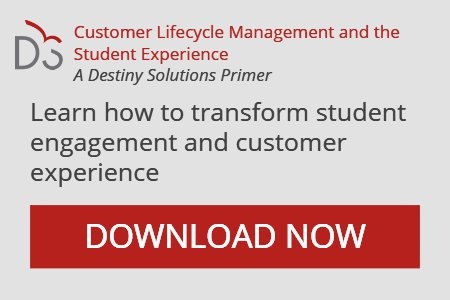Published on
Five Key Trends for Professional and Continuing Education Leaders in the Next Five Years

Higher education is on the cusp of major changes. Enrollments are on the decline—both online and on campus—and the trend is expected to accelerate.[1] Graduates are laboring under substantial college loan debts totaling more than $1.5 trillion.[2] Employers are demanding that applicants possess soft and hard skills that many college graduates do not hold.[3] At the same time new and emerging technologies are changing the way credentials are shared and work is done.
It is in this context that continuing, professional and online programs have been imported from the periphery to the center of traditional universities. Students and employers alike have made clear that their top priority is relevance to the rapidly changing workplace. Artificial intelligence, blockchain, augmented/virtual reality and other technologies are driving the changes. Professional and Continuing Education (PCE) has long been the leader in providing relevant courses, certificates and degrees that connect students with the needs of employers.
1. Rising Competition and Changing Market Demand
Paramount in planning for the near and longer term is knowing the marketplace for your students and the competition for your programs. What are employers seeking? Are you competing against large, low-cost MOOC-based degrees and other at-scale programs in your field? For example, expecting to approach the 10,000-major mark this fall, the Online Master’s Science in Computer Science degree at Georgia Tech is now the largest computer science program in the world. And the degree costs less than $9,000.[4] Those students might have enrolled in another online program—perhaps one at your university. If you were seeking the degree and qualified, would you choose the top-10-ranked Georgia Tech degree at that price point, or the program at your university?
Programs around the country need to differentiate their degrees and certificates if they hope to maintain or grow their majors in computer science and other fields.
- How is your program distinguished from the competition?
- Are your outcomes closely linked to the needs of the industry—both today and tomorrow?
- How are you preparing students for changes that smart technologies will make in your field?
2. Lives Will Extend (On Average) Beyond 100 Years, Impacting Learning Needs
We are entering an era where life expectancy is rising. It is expected that those who were born in year 2000 and after will live 100 or more years.[5] This is great news, but not without ripples throughout society. People will expect to work 60 or more years. They will need education along the way to keep pace with the changing technologies and needs in the workplace.
Harvard University Dean of the Division of Continuing Education and University Extension Hunt Lambert, University of California Irvine Dean of Continuing Education Gary Matkin, and University of Washington Vice Provost for Continuum College Rovy Branonare among those in our field leading the charge for the 60-Year Curriculum.[6] They suggest we must prepare for students coming back again and again for further education over an extended employment life. These students will be employed or recently unemployed, but all will be seeking to learn new technologies, techniques and practices that will enable them to advance.
- Are you designing a curriculum for returning students?
- Have you considered a “subscription” to updates for students who seek a continuous series of classes to keep them updated?
3. Backfilling the Soft Skills that Current Graduates Lack
Employers have identified soft skills that are lacking among job applicants.[7] These include communication, work ethic, computer, project management and problem-solving skills. This presents an opportunity for continuing, online and professional education units to offer short courses that, when completed, provide verification of these skills to employers. This opportunity cuts across disciplines; it is relevant to all fields.
4.Badging and Blockchain Credential Distribution
Increasingly, employers are seeking verification of learning, especially in soft and technical skills. In part, the advent of using artificial intelligence to efficiently sort through applicant credentials is driving this trend. The use of badges is one way to provide more information about the learning—and even provide student work examples—in courses and short certificates. Blockchain is offering an efficient way to distribute credentials—even degrees—that are verified and secured. Universities that respond to these two trends will put their graduates and students at the head of the job interview line.
5. Leveraging Artificial Intelligence and Virtual and Augmented Reality
Powerful emerging learning technologies are increasingly available to educators to provide better learning experiences to students. Artificial Intelligence is enabling personalized learning.[8] These technologies enable online delivery of learning in visual, interactive and personalized ways that engage the learner. These technologies will push learning outcomes to higher levels than we have seen in the past. By availing themselves of these powerful tools, professional, continuing and online educators will be able to distinguish their programs and attract more learners.
Shifting from the Periphery to the Core
This is an exciting time to be engaged in our field. We have moved from the periphery of the university to become its centerpiece. Our work engaging students for employment and advancement has become central to institution-wide strategic plans.
But we must be ever responsive to the changing marketplace, teaching and certification tools, and learning technologies if we are to be successful in this rapidly changing environment.
—–
References
[1] Jill Barshay, “College Students Predicted To Fall by More Than 15% After The Year 2025.” The Hechinger Report. September, 2018. https://hechingerreport.org/college-students-predicted-to-fall-by-more-than-15-after-the-year-2025/
[2] Zack Friedman, ” Student Loan Debt Statistics In 2018: A $1.5 Trillion Crisis.” Forbes. June, 2018. https://www.forbes.com/sites/zackfriedman/2018/06/13/student-loan-debt-statistics-2018/#3edc0eda7310
[3] Catherine Gewertz, “Speaking Skills Top Employer Wish Lists. But Schools Don’t Teach Them”. Education Week. September, 2018. https://www.edweek.org/ew/articles/2018/09/26/speaking-skills-top-employer-wish-lists-but.html
[4] Lindsay McKenzie, “Analysis Shows Georgia Tech’s Online Master’s in Computer Science Expanded Access”. Inside Higher Ed. March, 2018. https://www.insidehighered.com/digital-learning/article/2018/03/20/analysis-shows-georgia-techs-online-masters-computer-science
[5] 100yearlife.com. The Challenge – The 100-Year Life. http://www.100yearlife.com/the-challenge/
[6] Hunt Lambert, “Interview with Hunt Lambert – What is the 60-year curriculum?” https://www.youtube.com/watch?v=XgxvJuhLNek
[7] Penny Loretto, “The Top 12 Soft Skills Employers Seek”.The Balance Careers. November, 2018. https://www.thebalancecareers.com/top-soft-skills-employers-seek-1986632
[8] Ray Schroeder, “How Artificial Intelligence Can Help Achieve The Promise of Personalized Learning”. Inside Higher Ed. February,2019. https://www.insidehighered.com/digital-learning/blogs/online-trending-now/how-artificial-intelligence-can-help-achieve-promise
Author Perspective: Administrator




